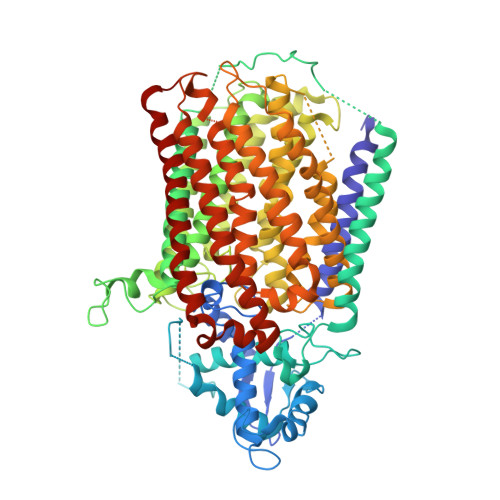Characterization of the quinol-dependent nitric oxide reductase from the pathogen Neisseria meningitidis, an electrogenic enzyme.
Gonska, N., Young, D., Yuki, R., Okamoto, T., Hisano, T., Antonyuk, S., Hasnain, S.S., Muramoto, K., Shiro, Y., Tosha, T., Adelroth, P.(2018) Sci Rep 8: 3637
- PubMed: 29483528
- DOI: https://doi.org/10.1038/s41598-018-21804-0
- Primary Citation of Related Structures:
6FWF - PubMed Abstract:
Bacterial nitric oxide reductases (NORs) catalyse the reduction of NO to N 2 O and H 2 O. NORs are found either in denitrification chains, or in pathogens where their primary role is detoxification of NO produced by the immune defense of the host. Although NORs belong to the heme-copper oxidase superfamily, comprising proton-pumping O 2 -reducing enzymes, the best studied NORs, cNORs (cytochrome c-dependent), are non-electrogenic. Here, we focus on another type of NOR, qNOR (quinol-dependent). Recombinant qNOR from Neisseria meningitidis, a human pathogen, purified from Escherichia coli, showed high catalytic activity and spectroscopic properties largely similar to cNORs. However, in contrast to cNOR, liposome-reconstituted qNOR showed respiratory control ratios above two, indicating that NO reduction by qNOR was electrogenic. Further, we determined a 4.5 Å crystal structure of the N. meningitidis qNOR, allowing exploration of a potential proton transfer pathway from the cytoplasm by mutagenesis. Most mutations had little effect on the activity, however the E-498 variants were largely inactive, while the corresponding substitution in cNOR was previously shown not to induce significant effects. We thus suggest that, contrary to cNOR, the N. meningitidis qNOR uses cytoplasmic protons for NO reduction. Our results allow possible routes for protons to be discussed.
Organizational Affiliation:
Department of Biochemistry and Biophysics, Stockholm University, Svante Arrhenius väg 16C, 10691, Stockholm, Sweden.

















